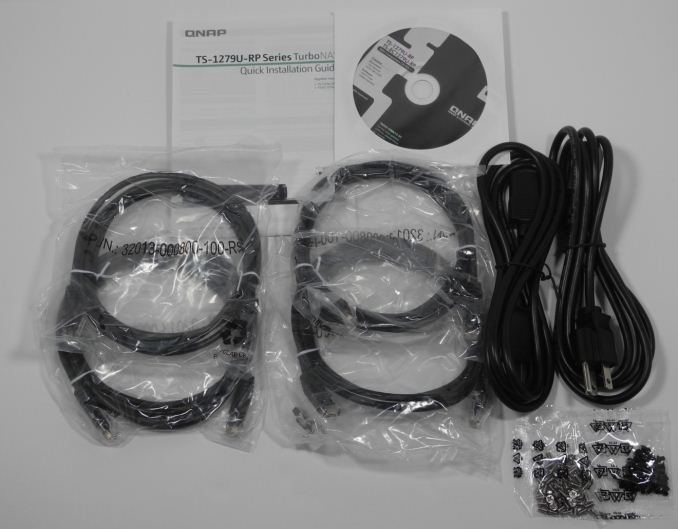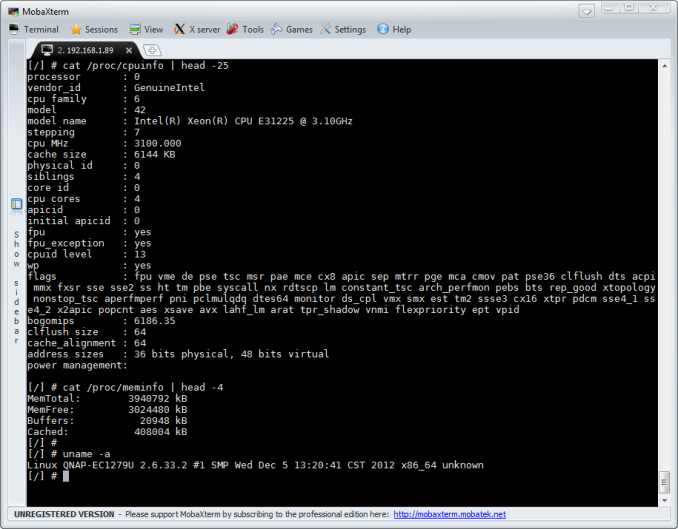QNAP's TS-EC1279U-RP 12-bay Flagship Rackmount NAS Review
by Ganesh T S on April 29, 2013 4:30 PM EST- Posted in
- Enterprise
- Storage
- NAS
- QNAP
Unboxing and Setup Impressions
The QNAP TS-EC1279U-RP package weighs in north of 50 pounds, with a diskless unit by itself coming in at 48 pounds (21.77 kg). As mentioned earlier, the unit is in the 2U form factor, with dimensions of 19" x 3.5" x 21". Along with the main unit, QNAP also bundles the following with the package:
- Quick Installation Guide and CD with QNAP utilities
- Four Cat 5e Ethernet cables
- Two US AC power plugs
- Screws for mounting hard disks in the drive bays
The front panel has twelve 3.5" drive bays arranged in three rows of four bays each. This leaves no room for a LCD display. The power button as well as status LEDs (network and power) are on the right side of the front panel. On the rear side, we have the VGA port for attaching a display, two USB 3.0 ports, two eSATA ports and four USB 2.0 ports. There are two GbE ports on the mainboard and two more on a half-height PCIe card. Two removable redundant power supplies round up the rear side of the unit. The power supplies are rated for 600 W each.
Inside the chassis, we have the E3-1225 CPU with a massive aluminium heat sink on top (passive cooling for the 95W CPU), one 4GB ECC DDR3 DIMM and a couple of spare SATA ports. The main board is isolated from the rear panel of the drive bays with three high speed fans which are user-replaceable (if the need arises). The SATA backplane consists of Marvell 88SE9125 SATA to PCIe bridges. There is one bridge chip for each SATA / SAS port, with a 6 Gbps SATA link on one side and a single PCIe 2.0 lane (5 Gbps) on the other.
On the software side, we found that not much has changed in terms of the UI since we reviewed the TS-659 Pro II. The setup process is very similar. There is an underlying assumption that the user / administrator is aware of various RAID levels (which is perfectly acceptable given the target market for this unit) as there is no automatic RAID level management. SSH access is available.
Even though multiple volumes can be created, a given disk can be a part of only one volume at a time. Disks can also be set up as hot spares. On the whole, the firmware has all the features that most IT admins would frequently use. In addition to the ability to configure the unit using the GUI, it would also be nice to have a CLI (command line interface) reference manual for this product level.
An overview of the setup process as well as the other features available in the current firmware is provided in the gallery below.
The firmware also comes with the ability to add more features using QPKG software expansion. There are a host of other features too, which we covered in detail in our review of the TS 659-Pro II. They are only of tangential relevance to this unit's target market, and hence, we won't go into detail into those features.
The disks can be set up in Single Disk, JBOD, RAID 0, RAID 5, RAID 6 or RAID 10 configurations. Available file systems are EXT3 and EXT4. Encryption is available on a per-volume basis.






























23 Comments
View All Comments
Evadman - Wednesday, May 1, 2013 - link
Why is this so expensive for the performance, and why is single client performance so bad? Granted I deal with actual enterpise class SAN devices from EMC and the like, but even my ~4 year old personal server can beat this box. My crappy home server is a 20 rotational Hitachi 3 TB GST Deskstar 0S03230 disks in RAID 60, a E5200 CPU and an Adaptec 52445 running on MS Server 2008, not even close to being decent for enterprise level. Besides the disks, it cost under a grand and will max out a quadlinked 4gbps connection with one client, I don't need to add 3 or 4 as your graphs show that this box needs. There is no excuse for a 20 rotational disk device to beat this 12 disk SSD NAS/SAN before hitting the network limit. I should get a dozen SSD's and a 10 gig switch and see what my crappy box can do just for kicks. *makes notes to see if a spare switch can be found in the office*ganeshts - Wednesday, May 1, 2013 - link
The single client performance is for a single client with a 1 GbE link (so it can't max out a 4GbE link obviously). Client machines usually have only a single GbE port.Our multi-client graphs show performance with multiple clients and indicate limitation because of the network link bandwidth on the NAS side
Evadman - Thursday, May 2, 2013 - link
I must be misreading the graphs being presented then. This real world graph: http://images.anandtech.com/doci/6922/qnap_ts1279u... shows 5 clients, each at ~20MB/s for a total of 80 MB/s. Theoretical maximum is 125 MB/s, Adding the control data to the payload of the frame, and you should have about 97.5% data. So it looks like it taking more than 5 clients to get to the 1gbps limit. On the single client CIFS graph here: http://images.anandtech.com/graphs/graph6922/54437... only 2 of the performance benchmarks appear network limited at 123 MB/s. Office Productivity is low at 25-28 MB/s, as that is probably what a small business is going to be doing the most of. Is this a client/CIFS issue and not a NAS/SAN issue?